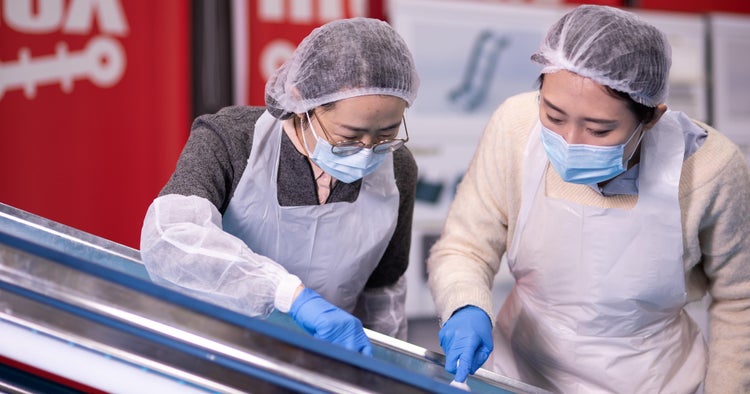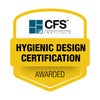The Costly Misperception About Hygienic Design
Four ways the right equipment can help you save time, money, and effort
- Insights
- October 31, 2022

Are you sitting down? OK, good.
In the first quarter of 2022, the U.S. Food and Drug Administration (FDA) recalled more units in the food sector than it did in total 2018–2021.
That’s more food items (1.3 million+) recalled in three months than during the past four years.
The consistent—and increasingly alarming—rise in food product recalls over the past several years has prompted a growing population in the industry to shift their thinking about hygienic design.
Many food manufacturers have operated under the misconception that hygienically designed equipment must cost more than traditional alternatives.
The truth is, if your plant is considering an update or a new capital project, the economic benefits of implementing hygienically designed equipment add up quickly.
As we shared in a previous article, when calculating the total cost of ownership (TCO) of a piece of equipment, it’s important to examine factors beyond the initial purchase price. For instance, what are the long-term costs involved?
Choosing hygienically designed equipment can save food manufacturers significant time, money, and effort. How?
Less Sanitation Time, More Uptime
How many sanitation staff members does it take to clean your current equipment? How much time is spent cleaning?
What if you could save an hour? Or an hour and a half? Conveyors with proper hygienic design can allow you to give some of the time spent on sanitation back to operations.
“If you're running the equipment, you're making money. You're making product,” says Brad Klemme, Commercial Food Sanitation Senior Food Safety Specialist. “During the sanitation process, you’re not. So the more you can compress that cycle time, the more financially beneficial it's going to be for your company, no matter which food category you work in.”
Going the route of hygienic design doesn't have to cost more. That's usually this misperception that people have. You need to factor in the total cost of ownership to get the full picture of what it will take to operate that piece of equipment over its lifetime.
Commercial Food Sanitation Senior Food Safety Specialist
Requires Less Training
This is an often-overlooked cost when calculating TCO. The more complex a piece of equipment is to operate and/or clean, the more training necessary. That’s especially difficult with the staffing challenges and high turnover rates many plants are experiencing.
“Owning pieces of equipment that require extensive training doesn’t jibe with what we’re seeing in the food industry right now from a staffing standpoint,” says Klemme.
Hygienically designed equipment doesn’t normally require thorough disassembly to clean or robust technical expertise to operate and maintain. That means you can train new team members more quickly and efficiently.
Team Tip: Partner with OEMs that understand, prioritize, and implement hygienic design principles in their equipment.
Easier to Clean
By design (literally), hygienic conveyor equipment is built with simplification in mind. Meaning, it requires less to function at a high level. That could mean not only fewer parts, but also less staffing.
Niche points are eliminated in hygienically designed pieces of equipment to prevent product buildup and the potential for micro harborage.
Conveyor equipment with a simple design can be cleaned more quickly. Sanitors can easily access all its areas. There is also little to no disassembly involved (and no tools are needed if it is required).
Equipment that’s more complex and closed up takes longer to clean effectively, which costs food manufacturers more money in water, chemicals, and labor needed.
Periodic Equipment Cleaning (PEC)
The more complicated the equipment, the more moving parts it has, the harder it is to apply all the hygienic principles to totally eliminate the need for some degree of a PEC teardown.
“When your maintenance and sanitation groups have to regularly collaborate and dismantle the equipment just to clean it effectively, that gets really costly,” says Klemme.
Does your company have a PEC program in place? If not, there may be a food safety risk present that you’re unaware of, which could cross-contaminate with your product. Left unchecked, this is the type of hidden cost that could grow into the worst kind of result for your company: a product recall.
“It’s kind of like swimming in shark-infested waters and not knowing you’re in shark-infested waters,” explains Klemme. “Without a PEC program, you don’t know what you don’t know. And that’s the scary part.”
With all the long-term, cost-saving benefits of choosing hygienically designed equipment for your food manufacturing operations, the real question is, can you afford NOT to do so?
When it’s time to purchase new equipment or modify your existing systems, hygienically designed options offer what Klemme describes as, “win-win solutions.”
For one, the food safety and cleanability benefits are clear. But the other is a financial win. Hygienically designed equipment can run at a longer term for a lower cost. Over time, that can dramatically affect your total cost of ownership.
If you’re looking to justify a new project to plant leadership, an equipment solution that improves food safety, reduces risk, delivers more uptime, and costs less over the long term should get their attention.
Preventing the worst outcome for your plant begins with choosing the right equipment. Make hygienic design improvements a priority and you won’t be sacrificing financial outcomes to meet food safety goals. Show company officials the full TCO picture and how, with a long-term view, they can have both.
If you’d like to know more about the economic and food safety benefits of hygienically designed equipment, connect with the experts at Intralox and CFS.

